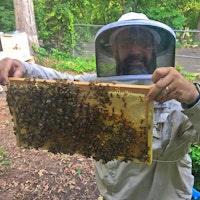Meet the amazing (and super cute) jumping spider
Discovery Place Nature
Spiders are amazingly diverse, not only as far as species, but also in how they look. Some spiders are readily recognized, like the wolf spiders, orb weavers and tarantulas. Recently, at the Museum, we brought in a jumping spider called the Canopy Jumper (Phidippus otiosus), another readily recognized family of spiders.
Jumping spiders make up the largest family of spiders, Salticidae, which is found worldwide and has over 5,000 species and comprises a whopping 13 percent of all spiders. In the United States, we have roughly 300 species of jumping spiders.
In our specific area of the country, most jumping spiders are small, averaging about a quarter inch to a half inch in length. They have fuzzy bodies, move around in a start-stop, staccato rhythm and, of course, jump. However, their most recognizable feature is their face, which features a pair of large, round, forward-facing eyes.

These spiders are not dangerous and, due to their appearance, don’t seem to be as threatening as other spiders. However, if you are potential prey, you may think differently!
These little spiders are amazing hunters that actively hunt and even stalk their prey. They don’t use webs to sit and wait. These little predators will track, follow and ambush prey by pouncing on them from a variety of perches and cover, many times taking an impressive leap after flying insects. Of course, they don’t hunt with reckless abandon. They use a safety “rope” of silk in case they miss and also use the silk to crawl back up to their perch.
Because jumping spiders are active hunters, they not only need to have good vision, but they also must gauge depth and actively focus when pouncing on their prey. So how does such a small critter, with such a small brain, no ability to move its head back and forth do this as well at focusing? This has baffled scientists for years, but recent studies have discovered that jumping spiders’ eyes are quite complex.

While its other eyes detect motion, the two main eyes are the most complex, having roughly four layers of photoreceptor cells in their retinal membranes. Two of the membranes can detect UV light, but the deeper layers specialize in detecting the green light spectrum, which is what holds the key. The first green-sensitive layer receives an image that is fuzzy, but the deepest green layer receives a focused image. According to the scientists that performed the study, the depth perception is based on just how out of focus the fuzzy layer is, which is proportional to the distance the object is from the spider’s eyes.
Apparently, green light is the color that is just right for this spider’s depth perception. Not only is this an amazing discovery, but it has implications for computerized vision in robots and other technology!
In addition to their leaping abilities, their undeniable cuteness and amazing vision, it’s no wonder the jumping spider is a favorite of spider fans and nature-lovers alike.
If you want to see our little canopy jumping spider (Phidippus otiosus), seen in the photos, come to Discovery Place Nature.
Photos by Discovery Place Nature Director Marvin Bouknight.

